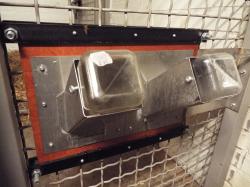Methods
Taste stimuli
|
Acesulfame K |
A high-potency, non-caloric artificial sweetener about 200 times sweeter than sucrose to humans. |
|
Alitame |
A high-potency, non-caloric artificial sweetener about 2000 times sweeter than sucrose to humans. |
|
Aspartame |
A high-potency, non-caloric artificial sweetener about 200 times sweeter than sucrose to humans |
|
Sodium saccharin |
A high-potency, non-caloric artificial sweetener about 300-400 times sweeter than sucrose to humans. |
|
Monellin |
A high-potency, naturally occurring sweetener about 800-2000 times sweeter than sucrose to humans. Chemically a protein found in the fruit of the West African serendipity berry (Dioscoreophyllum cumminsii). |
|
Thaumatin |
A high-potency, naturally occurring sweetener about 2000 times sweeter than sucrose for humans. Chemically a protein found in the West African katemfe fruit (Thaumatococcus daniellii). |
|
Galactose |
A low-potency, naturally occurring sweetener about 30% as sweet as sucrose to humans. Chemically a monosaccharide and a constituent of the disaccharide lactose found in mammalian breast milk. |
|
Glycine |
A low-potency, naturally occurring sweetener about 60% as sweet as sucrose to humans. Chemically the most simple proteinogenic amino acid. |
|
Polycose |
A low-potency, naturally occurring sweetener. Chemically a soluble glucose polymer (and thus a soluble starch). |
|
Sorbitol |
A low-potency, naturally occurring sweetener about 60% as sweet as sucrose to humans. Chemically a sugar alcohol occurring naturally in some fruits. |
Experimental set-up

Three adult West African chimpanzees (Pan troglodytes verus) housed at Borås Zoo in Sweden were the subjects of the present study.
In order to assess the taste responses of the chimpanzees they were simultaneously presented with two drinking bottles, one containing a sweet-tasting substance and one containing tap water. To this end, I used three drinking stations, one per chimpanzee. Each drinking station consisted of two metal bottle holders attached to a wooden board which was permanently attached to the metal fencing inside the enclosure.
Experimental procedure
A two-bottle preference test of short duration was used. During each trial, each chimpanzee was presented simultaneously with two graduated plastic containers with metal drinking spouts. One container was filled with 100 ml of a given taste substance diluted in tap water to a predetermined concentration and the other was filled with 100 ml of tap water. Each trial ended after 1 minute or when one of the liquids had been completely consumed, upon which both bottles were taken away from the bottle holders. Both bottles were weighed before and after testing in order to record the consumption of liquid in each container.
Testing was carried out using one substance at a time and each concentration of a given taste substance was presented ten times per animal. Different concentrations of a substance were presented in a pseudo-randomised way both within and between testing sessions. The position of the bottle containing the sweet-tasting substance was also pseudo-randomised between trials such that it was positioned to the left or right side an equal number of times.
Data analysis
The taste preference threshold for each substance was determined as the lowest concentration at which there was a preference over water according to two criteria:
Responsible for this page:
Director of undergraduate studies Biology
Last updated:
05/07/19
